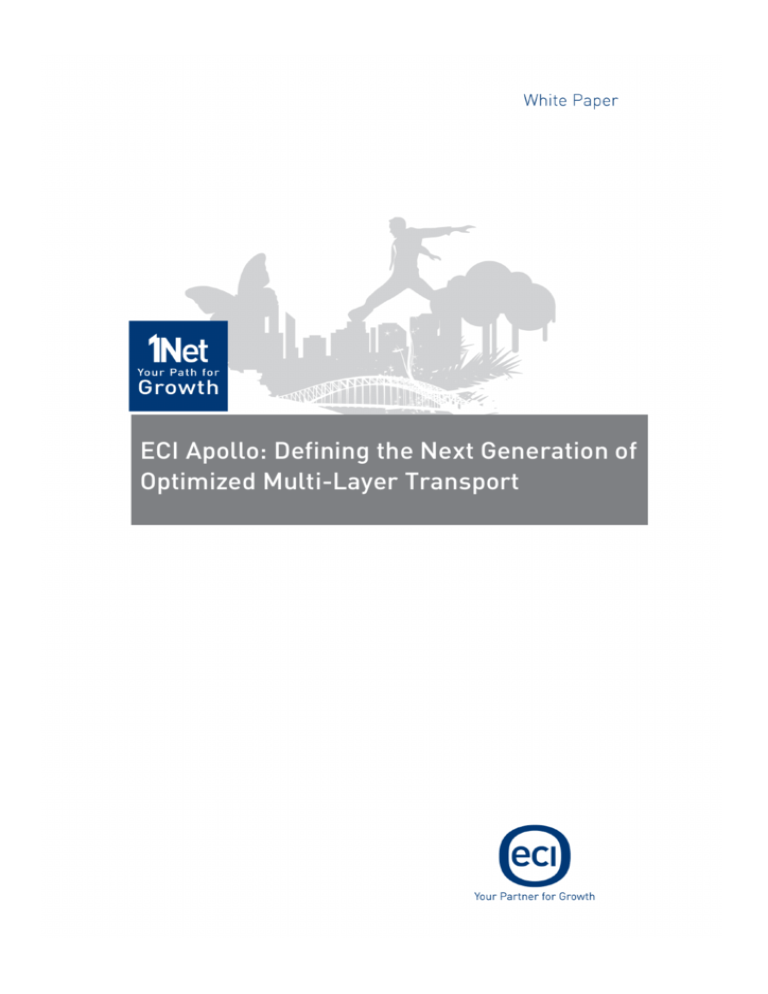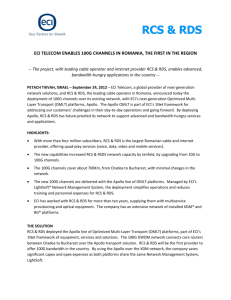
ECI Apollo: Defining the Next Generation of
Optimized Multi-Layer Transport
ECI Apollo: Defining the Next Generation of Optimized Multi-Layer Transport
White Paper
September 2011
© Copyright by ECI Telecom, 2011. All rights reserved worldwide.
The information contained in the documentation and/or disk is proprietary and is subject to all relevant copyright, patent, and other laws
protecting intellectual property, as well as any specific agreement protecting ECI Telecom's rights in the aforesaid information. Neither
this document nor the information contained in the documentation and/or disk may be published, reproduced, copied, modified or
disclosed to third parties, in whole or in part, without the express prior written permission of ECI Telecom. In addition, any use of this
document, the documentation and/or the disk, or the information contained therein for any purposes other than those for which it was
disclosed, is strictly forbidden. ALL RIGHTS NOT EXPRESSLY GRANTED ARE RESERVED BY ECI TELECOM.
Any representation(s) in the documentation and/or disk concerning performance of ECI Telecom product(s) are for informational
purposes only and are not warranties of product performance or otherwise, either express or implied. ECI Telecom's standard limited
warranty, stated in its sales contract or order confirmation form, is the only warranty offered by ECI Telecom.
The documentation and/or disk is provided “AS IS” and may contain flaws, omissions, or typesetting errors. No warranty is
granted nor liability assumed in relation thereto, unless specifically undertaken in ECI Telecom's sales contract or order
confirmation. Information contained in the documentation and in the disk is periodically updated, and changes will be
incorporated in subsequent editions. If you have encountered an error, please notify ECI Telecom. All specifications are
subject to change without prior notice.
CONTENTS
Table of Contents
The Challenges...................................................................................................................... 5
What Operators Need to Meet These Challenges ............................................................... 6
The Operator Response .................................................................................................. 7
The Solution Operators Really Need .................................................................................... 8
Offerings To Date ............................................................................................................. 8
Optimized Multi-Layer Transport ......................................................................................... 9
ECI’s Apollo OMLT ........................................................................................................... 9
The Apollo Platforms .......................................................................................................... 12
Passive Modules ............................................................................................................ 13
Apollo Network Applications .............................................................................................. 14
Apollo Architecture and Technologies ......................................................................... 15
Apollo Support for Services ................................................................................................ 17
Apollo Makes the Difference .............................................................................................. 19
Conclusion ........................................................................................................................... 20
About ECI Telecom.............................................................................................................. 20
ECI Telecom Ltd. Proprietary
iii
CONTENTS
List of Figures
Figure 1: The architecture of the Apollo product range ................................................. 10
Figure 2: The ECI Apollo product range in the network ................................................. 11
Figure 3: The Apollo 9600 OMLT portfolio – active platforms ........................................ 12
Figure 4: The Apollo solution’s Artemis series of passive modules .............................. 13
Figure 5: Router offload and savings by switching at the lowest possible layer............ 15
Figure 6: ECI Apollo multi-layer management with LightSoft ....................................... 16
List of Tables
Table 1: Apollo OMLT OPT9600 series* .......................................................................... 13
Table 2: Network applications with optimized Apollo platforms – example
configurations of OPT9624 cage ...................................................................................... 14
Table 3: Apollo support for services................................................................................ 17
Table 4: Flexibility of ECI’s Apollo OMLT ......................................................................... 19
iv
ECI Telecom Ltd. Proprietary
THE CHALLENGES
The Challenges
The rapid evolution of new packet services, the resulting changes in traffic mix,
and declining revenue per bit have collectively issued operators a mandate:
Overcome planning uncertainty; acquire greater cost-effective scalability; utilize
bandwidth and network assets better; and manage network performance more
effectively. Operations must be streamlined and total cost of ownership (TCO)
minimized. Greater flexibility to create new and differentiated services more
quickly and cost effectively is essential. And, with all this, equally effective
support for packet-, circuit-, and wavelength-based services is required.
ECI Telecom Ltd. Proprietary
5
WHAT OPERATORS NEED TO MEET THESE CHALLENGES
What Operators Need to Meet These Challenges
Achieving the new scalability, performance, manageability, and revenue objectives
which the evolving market environment demands, and doing so cost effectively,
require that operators adopt a more efficient approach to building and operating
networks. A more flexible, efficient, manageable, and automated next-gen (NG)
transport solution is needed, one that integrates packet and optical technology in an
innovative way that provides support for legacy services while being optimized for
delivering high-growth services.
This new solution must offer maximum bandwidth efficiency, provide the ability to
dynamically allocate network resources when and where needed most, take
advantage of increased automation, and offer greater awareness and control over
the network. But the savvy operator knows that ongoing success requires more than
simply the better leveraging of network assets and control of network costs. It also
requires the capability to flexibly and rapidly create new services and to ensure a
differentiated experience for customers, so that profitable new revenue streams can
be built. It is necessary to fine-tune control of QoS down to the per-service or
individual customer level, and to correlate management events and conditions
across network layers.
Integration of network layers into one device has sparked very strong interest from
operators worldwide. It provides potential synergies in packaging, power, ports,
cabling, and network management, resulting in expected cost savings and network
simplification. The declining revenue-per-bit yield from bandwidth-intensive
packet services has made more efficient use of network bandwidth a critical
objective for operators. This need for greater efficiency has led to a heightened
interest in meshed restoration, since the cost of dedicating bandwidth resources
solely to the function of protection has become increasingly prohibitive in this new
market environment.
Cost pressures have also led to increased interest in maximizing the efficiency of
aggregation networks. That, plus the advantages of service transparency, effective
support of legacy SDH/SONET traffic, and the need for scalability to 100G and
beyond, has led to the creation of a standards-based multiplexing hierarchy and to
offering Layer 1 switching that allows efficient grooming of electrical domain
services onto wavelengths.
The need for more deterministic Ethernet performance has created a demand for
enhanced OAM. The need for operational synergies with the IP/MPLS core has led
to the development of metro-friendly Layer 2 protocols that streamline MPLS to
provide a more cost-effective Layer 2 alternative for the metro. The need for
standardization has encouraged wide support of MEF-certified Ethernet services.
The rise of mobile computing and growing interest in Cloud services have brought
about two main changes: bandwidth demand is increasingly dynamic, and the
locations and timing of bandwidth use increasingly uncertain. It is therefore
increasingly important to dynamically allocate network resources when and where
needed, a function of multidegree wavelength-switching capabilities that offer
greater flexibility and are non-blocking in nature. At the same time, the need for
greater automation, more efficient restoration mechanisms, and a tighter coupling
of the optical transport network with higher and more intelligent network layers has
heightened operator interest in a control plane that spans layers, particularly when
used in conjunction with reconfigurable networks offering dynamic
wavelength-switching capabilities.
6
ECI Telecom Ltd. Proprietary
WHAT OPERATORS NEED TO MEET THESE CHALLENGES
The evolution of packet services from “best effort” to an expanded service
portfolio with tiered services that include more differentiated and deterministic
offerings, has led operators to take greater interest in a better OAM model, one
equally applicable to all traffic types. Operators are increasingly focused on
growing their portfolio of differentiated packet services and on being able to
respond quickly to new service opportunities. Their aim is to ensure a good quality
of experience for those services while potentially supporting some of them with
marketable SLAs. Quick fault detection, correlation, and problem resolution are
required. For a network offering a mix of packet and circuit services while
leveraging underlying optical transport, a multi-layer network management
solution is needed to help operators correlate service performance to what is going
on across multiple network layers. Last but not least, the need to streamline
operations has led to increasing interest in automated provisioning and to stronger
linkages between provisioning and planning tools.
The Operator Response
As they examine changing market requirements and the impact of new services on
their revenue opportunities and network operations objectives, an increasing
number of service operators are coming to a conclusion: The time is right to
integrate network elements (NEs) and associated network management spanning
L0, L1, L2, and elements of Layer 3 intelligence, while leveraging the most
cost-effective network layer that provides the required functionality.
The operators expect this to achieve both CAPEX and OPEX savings while
meeting “green” initiatives. However, to date, many operators have moved
cautiously toward this goal. Although it offers many potential benefits, it also
involves potential pitfalls or lost opportunities if not done with the right design
approach and architecture. So, although operator interest in greater integration of
network layers has remained strong, lessons learned have often left them waiting
for a solution that better meets their long-term needs.
ECI Telecom Ltd. Proprietary
7
THE SOLUTION OPERATORS REALLY NEED
The Solution Operators Really Need
Offerings To Date
While much of the technology in the first generations of packet-optical transport
platforms was mature, its implementation led to relatively slow uptake. Vendors
tried to repurpose existing platforms and leverage past development expenditures
rather than innovate in developing the best mix of packaging, architecture,
technologies, and operating paradigm. As a result, they developed suboptimal
solutions that better met their needs than solve the operators’ problems.
(For a more in-depth discussion on why many early packet-optical transport
solutions were sub-optimal, refer to Telecom Strategy Partners’ White Paper
entitled “Replacing the Packet-OTS: What Operators Need In Next-Gen
Transport”.)
The New Solution: Optimized Multi-Layer Transport (OMLT). What operators
really need is NG transport infrastructure that fully marries the scalability,
performance, cost, and OAM model of optical networks with the adaptability, cost
efficiencies, and flexible service-creation opportunities of packet networks.
Operators need a portfolio of products which build a more intelligent, efficient, and
flexible network that integrates packet and optical technology, scales cost
effectively, makes maximum use of network resources, minimizes TCO, and
enables the creation of new revenue opportunities while protecting existing revenue
streams. In other words, they need an intelligent, fully integrated multi-layer
transport solution that simplifies operations and optimizes performance and cost for
a diverse and changing mix of packet-, circuit-, and wavelength-based services.
The architecture must accommodate different network starting points and different
future objectives. It needs to reduce the necessity for planning certainty, minimize
up-front CAPEX, eliminate the potential stranding of assets, and future proof the
network investment. Consistent carrier class OAM applied to all traffic types in the
network must be offered, and operators must have the ability to transport circuit,
packet, and wavelength traffic equally well while supporting tiered service levels
and marketable SLAs. The result must be an intelligent multi-layer transport
network that can respond to traffic load and network impairments, dynamically
allocate bandwidth and reroute traffic when and where required, so directing traffic
to the most cost-effective network layer that best meets the functional requirements
and cost objectives of each part of the network.
The repurposed packet-optical transport platforms of the past have not been the
solution. What operators need is a new breed of infrastructure, an optimized multilayer transport (OMLT) platform.
8
ECI Telecom Ltd. Proprietary
OPTIMIZED MULTI-LAYER TRANSPORT
Optimized Multi-Layer Transport
The intelligent NG OMLT solution must be based on mature and proven L0, L1,
L2 technologies and management with L3 intelligence, and incorporate an
innovative design philosophy and modular architecture that enable strategic
flexibility and fine-tuned control of the network. It should integrate packet and
optical networks in a way that maximizes the full cost-containment and
revenue-creation synergies possible, while providing the greatest flexibility,
performance, control, and manageability possible. Operators need a low first-in
cost, a pay-as-you-grow approach, future proofing, streamlined operations,
minimized TCO, and the ability to quickly allocate network resources when and
where needed, as well as the flexibility to maximize new revenue opportunities.
ECI’s Apollo OMLT
ECI has taken a market-leading position in defining and rolling out the unique
combination of architecture, technology, and packaging needed to make OMLT a
reality. The Apollo is a groundbreaking, purpose-built, NG modular transport
portfolio integrating L0, L1, and L2 plus L3 intelligence, providing a strong OAM
model equally applicable to circuit and packet traffic, and offering an integrated
multi-layer management view. A range of active cost-optimized platforms are part
of end-to-end solutions that span metro access, edge, and core/regional/long haul
requirements.
The product of ECI’s extensive transport experience together with operator input
and market-leading optical technology and innovation, the Apollo OMLT
combines ECI’s well-recognized strengths in transport with best-in-class packet
networking technologies and integrated multi-layer management. The modular
design and practical focus of Apollo’s innovative architecture give operators the
opportunity to build the best solution for their needs today, while ensuring they
keep the door open for the right solution in the future. And it incurs no penalty or
stranding of assets for the operator, regardless of the pace or path with which they
choose to address the migration from circuit to packet traffic. For those operators
with the eventual goal of convergence of all packet and circuit traffic onto a single
packet network, Apollo provides an ideal, practical, and cost-effective migration
path toward that objective, and an optimal solution when the operator gets there.
Based on modular building blocks and a series of cost-optimized platforms, Apollo
gives operators the option to start implementing either a complete, optimized,
multi-layer transport solution, or only selected sections of that solution on a
standalone basis as needed (for instance, the operator can start out only with optical
transport or Carrier Ethernet switch router capabilities and add more functionalities
as needed). This can be done without fear of stranding assets, or having initialdeployment decisions limit future options, or committing to a solution that is less
optimized for one type of traffic in favor of another – providing operators with
significant future proofing. Apollo’s modular design and innovative architecture
offer an effective solution regardless of a network’s “starting point” or the
operator’s future objectives. The Apollo range of platforms offers choices in
scalability, functionality, and cost objectives for each part of the network.
ECI Telecom Ltd. Proprietary
9
OPTIMIZED MULTI-LAYER TRANSPORT
Designed “from the ground up” as a purpose-built OMLT solution, the Apollo
portfolio provides operators with all the advantages and synergies of a tightly
integrated, intelligent system. Depending on their needs, operators can scale to 44
or 88 wavelengths, deploy a centralized switch fabric or not, and deploy IP/MPLS
and MPLS-TP where needed as part of an end-to-end solution. Figure 1 shows the
basic architecture upon which the Apollo product range is built.
Figure 1: The architecture of the Apollo product range
Gaining true operational efficiency requires an end-to-end solution with
cost-optimized platforms for each part of the network, a common management
system, and common interfaces to operational support systems (OSSs) that give
operators flexibility while streamlining the number of different platforms that must
be managed.
10
ECI Telecom Ltd. Proprietary
OPTIMIZED MULTI-LAYER TRANSPORT
Figure 2 shows the ECI Apollo product range deployed in the network from metro
access, core, and core/regional roles.
Figure 2: The ECI Apollo product range in the network
ECI Telecom Ltd. Proprietary
11
THE APOLLO PLATFORMS
The Apollo Platforms
The Apollo 9600 series of OMLT platforms comprises a complete range of
products providing cost-optimized functionality for networks ranging from metro
access to metro edge, metro core, and regional/long haul. The Apollo platforms are
complemented by ECI’s series of Artemis modules, which provide passive optics.
The active platforms in the Apollo solution are shown in Figure 3.
Figure 3: The Apollo 9600 OMLT portfolio – active platforms
The Apollo SR9601 and OPT9603 are compact platforms for metro access needs.
The Apollo SR9604 and OPT9608 are for use at the metro edge, and feature 4 and
8 I/O slots, respectively, in a stackable chassis that can be deployed simply as
WDM or can include 100 Gbps full duplex of Ethernet/MPLS packet-switching
capabilities. The Apollo OPT9624 and OPT9648 are for metro core and
regional/long haul applications and offer 24 and 48 I/O slots in a stackable chassis,
include a terabit universal switch for ODU cross connect and packet-switching
functionality, and provide options for deployment of standalone DWDM or for
DWDM and the addition of OTN and packet functionality. Table 1 summarizes the
capabilities of the Apollo OPT9600 series platforms.
12
ECI Telecom Ltd. Proprietary
THE APOLLO PLATFORMS
Table 1: Apollo OMLT OPT9600 series*
Platform
SR9601
Summary description
OPT9603
SR9604
OPT9608
OPT9624
OPT9648
Access
Pizza box form factor
10G Ethernet/MPLS switching capacity full duplex
Access
3 I/O slots
Metro edge
4 I/O slots
50G Ethernet/MPLS switching capacity full duplex
Metro edge
8 I/O slots
100G Ethernet/MPLS switching capacity full duplex
Metro core/regional
24 I/O slots
Universal OTN/packet switching fabric
Terabit switching capacity
Regional/long haul
48 I/O slots
Universal OTN/packet switching fabric
Terabit switching capability
*Includes support for OTN and ODU-level OTN switching, offers 2-degree ROADM and
multidegree directionless, colorless, and contentionless ROADM, and a unique MPLS-TP
to IP/MPLS gateway. In addition, it offers strong support for L2 Carrier Ethernet and L3
MPLS services, as well as SDH circuits, storage networking protocols, and wavelength
services.
Passive Modules
The Apollo OPT9600 series platforms are complemented by the Artemis series of
passive modules, shown in Figure 4.
Figure 4: The Apollo solution’s Artemis series of passive modules
Artemis provides a complete range of cost-optimized 1U, 2U, and 4U sized cages
for passive modules offering dispersion compensated fiber, Mux/DeMux
functionality, fixed OADM (FOADM) capabilities, and splitters/couplers. The 1U,
2U, and 4U cages house 2, 4, and 8 passive cards, respectively. Note that the
passive cards can also be installed directly in the Apollo cage.
ECI Telecom Ltd. Proprietary
13
APOLLO NETWORK APPLICATIONS
Apollo Network Applications
The flexible Apollo can be custom tailored as a platform optimized for a number of
applications. Table 2 highlights some of the network applications for which the
Apollo OPT9624 and OPT9648 platforms can cost effectively be optimized, thanks
to their modular design ranging from pure WDM deployment to metro packet OTS,
metro/core/regional packet OTS, or CESR platform.
Table 2: Network applications with optimized Apollo platforms – example configurations of
OPT9624 cage
Pure WDM application
24 universal slots
♦ Photonic modules
♦ L1 service cards
Metro Core/Regional/LH OMLT
4 slots for 1 Tbps universal fabric cards
20 universal slots
♦ Photonic modules
♦ L1 service cards
♦ L2 / L3 data cards
CESR application
4 slots for 1 Tbps universal fabric
cards
20 universal slots
♦ L2 / L3 data cards
Metro OMLT Application
2 slots for 100G fabric cards
22 universal slots
♦ Photonic modules
♦ L1 service cards
♦ L2/L3 data cards
Apollo provides an end-to-end packet-optical solution that is remotely
reconfigurable from access to core. Apollo also enables operators to engage in a
router and ODU-XC offload approach, saving routing functionality for the traffic
that really needs it and following a multi-layer version of the “route where you
must, switch where you can” philosophy which provides strong cost optimization.
Because of the modular design, operators have the flexibility to minimize initial
CAPEX and upgrade capabilities only when needed. For instance, Apollo can first
be deployed as an optical solution providing wavelength services to a building,
then upgraded with Carrier Ethernet capabilities to provide GbE services to a
nearby cell tower. Or an initial deployment of Carrier Ethernet in support of PON
can be upgraded with additional optical wavelengths in order to transition from
broadcast video to more personalized video on demand services. And, as operators
with an LTE network have an increasing mix of peer-to-peer traffic in the metro,
they might choose to add packet technologies to an initial optical deployment to
support the greater meshed traffic patterns they must serve.
14
ECI Telecom Ltd. Proprietary
APOLLO NETWORK APPLICATIONS
Figure 5 illustrates the options and cost benefits that Apollo offers in terms of
router offload. This will become an increasingly valuable tool for operators as a
higher percentage of links in the network migrate to 40G and 100G capacity.
Figure 5: Router offload and savings by switching at the lowest possible layer
Apollo Architecture and Technologies
In the Apollo portfolio, ECI has selected the right mix of technologies that carriers
need to build the OMLT network that maximizes revenues and minimizes costs in
the future. ECI offers MPLS-TP as a cost-optimized complement to the IP/MPLS
core. The ECI Apollo OMLT can leverage MPLS-TP for applications such as
mobile backhaul, where limited path diversity requirements make it a more
cost-effective approach than MPLS, given there is no need to reference large
routing tables. Further, it provides an efficient gateway to interconnect the MPLSTP and IP/MPLS domains. ECI implements OTN switching at the ODU level,
offers directionless, colorless, and contentionless ROADM technology, and utilizes
a GMPLS control plane.
From the perspective of architecture, ECI has implemented a universal fabric that,
in addition to packet switching, provides OTN switching at the ODU level. The
chassis of Apollo 9600 series platforms features universal I/O slots and the
modular design enables selective deployment of technologies as and when needed.
And an end-to-end integrated multi-layer management view provides correlation
between services, customer experience, and network performance.
Universal fabric ensures there is no stranding of assets over time as the traffic
mix changes, and support for OTN as well as packet traffic ensures strong
multiservice support of both new packet and legacy circuit-based services.
Universal I/O slots ensure full utilization of each chassis and backplane and
also eliminate the potential stranding of any I/O card assets. Photonic modules
and service cards can be installed in any of the universal slots. In standalone
optical configuration, the fabric slots are used as any other universal slot in the
system, so utilizing all the slots.
Modular design ensures operators have a low “first in” cost, not paying for
functionality not needed, and operating a “pay as you grow” model by scaling
I/O and adding new technologies, such as WDM or CESR, only when needed.
ECI Telecom Ltd. Proprietary
15
APOLLO NETWORK APPLICATIONS
Leading density of 100 XFPs per cage or 300 per rack gives operators highly
efficient footprint and power requirements.
Integrated multi-layer management by the ECI LightSoft® management
system gives operators full FCAPS support for all ECI transport equipment and
technologies, shortening the learning curve. It provides advanced automatic
path finding, and takes a multi-layer topology approach by offering multiple
task-specific views of the network. By offering unified OAM, alarm
correlation, and root cause analysis spanning the data and optical layers, and
correlating that with the network topology, it provides a complete view of the
network that simplifies management tasks and reduces the length of
out-of-service periods.
The LightSoft network manager and ECI’s multi-layer management are shown in
Figure 6.
Figure 6: ECI Apollo multi-layer management with LightSoft
16
ECI Telecom Ltd. Proprietary
APOLLO SUPPORT FOR SERVICES
Apollo Support for Services
Apollo supports Layer 2 services and MPLS and Layer 3 services, as shown in
Table 3.
Table 3: Apollo support for services
L2 Carrier Ethernet features and
services
MEF-certified E-Line, E-LAN, E-Tree
services
802.3ad link aggregation
802.1ad provider bridging and VLAN
stacking
L2/3 Hierarchical QoS
L2/L3 classification and filtering
IEEE 802.1ag, Y.1731/1711, 802.3ah
hardware-assisted OAM
IEEE 802.1d STP, 802.1w RSTP, 802.1s
MSTP, per VLAN STP
MPLS and L3 features and services
Hierarchical VPLS including auto-discovery
Point-to-point PWE3
RSVP-TE signaling
LDP signaling
MPLS fast re-route (FRR)
Primary/secondary standby LSPs
MPLS-TP and IP/MPLS signaling gateway
BFD and Y.1731 OAM
The technologies ECI has chosen to incorporate in Apollo are geared to the OMLT
solution of the future, and include:
MPLS-TP enables operators to leverage operational synergies with the
IP/MPLS core while offering a Layer 2 technology that complements full
MPLS with a lower cost and streamlined “profile” of MPLS functionality
appropriate for the metro and access networks. MPLS-TP enables
consolidation of metro access and aggregation networks onto a common
Carrier Ethernet/MPLS infrastructure that effectively supports converged fixed
and mobile services, and provides deterministic performance for applications
such as mobile backhaul. MPLS-TP also provides flexible QoS and strong
OAM, resilience, and protection-switching capabilities. The use of MPLS-TP
rather than a full Layer 3 implementation can also enhance security by
eliminating the need for NEs to have IP addresses that expose them to potential
attacks on the network.
OTN provides FEC, transparency, a standards-based multiplexing hierarchy,
and effective support for legacy circuit traffic, storage protocols, and
wavelengths. OTN Switching at the ODU level enables aggregation down to
the GbE, enabling efficient electrical grooming of services onto optical
wavelengths in the metro core and regional network to ensure maximum
bandwidth efficiency and network utilization. The OTN switch provides the
NG Layer 1 replacement to the legacy SDH/SONET cross connect.
ECI Telecom Ltd. Proprietary
17
APOLLO SUPPORT FOR SERVICES
18
Choices in ROADM give operators the chance to implement a cost-effective
2-degree ROADM for add/drop on rings, or a more capable multidegree
colorless, directionless, and contentionless ROADM that enables dynamic
switching of wavelengths onto network paths, allows for color conversion of
wavelengths as needed, and offers a full non-blocking architecture.
GMPLS Control Plane automates discovery of NEs, cards, neighbors, and
network topology, optical equalization, connection management, and routing
(through route computation), and provides multiple protection and restoration
options to increase survivability and create differentiated service offerings.
With a single GMPLS control plane spanning both the packet and optical
layers, operators gain benefits such as operational cost savings and faster
service activation times.
ECI Telecom Ltd. Proprietary
APOLLO MAKES THE DIFFERENCE
Apollo Makes the Difference
Apollo provides operators with an innovative mix of packaging, multi-layer
management, and modular architecture designed to create the greatest flexibility,
opportunity for service differentiation, and operational efficiency possible. The
mature and proven optical and packet networking technologies upon which Apollo
is based aim to maximize service revenues and minimize costs. The Apollo
portfolio enables operators to build an end-to-end OMLT network while reducing
the number of different NE types in the network, simplifying operations, reducing
footprint and power requirements, and providing a single interface to OSSs. And
ECI’s LightSoft manages ECI’s entire transport portfolio, including microwave,
DWDM, MSPPs, and CESR platforms, providing significant potential for
operational synergies throughout the network.
Apollo fully integrates L0, L1, L2, and elements of Layer 3, reducing packaging
costs and the port consumption and cabling requirements associated with discrete
NEs. Apollo’s modular architecture gives operators the flexibility to selectively
deploy only the network functionality they require, minimizing unnecessary “up
front” capital expenditures while enabling “pay-as-you-grow” scalability. Apollo’s
universal I/O slot architecture ensures that the chassis and backplane are fully
utilized. And Apollo provides full integration, not only of hardware, but also of
management, offering correlated multi-layer and task-sensitive views spanning the
entire network end-to-end.
In terms of ECI-wide portfolio synergies, the Apollo 9600 OMLT portfolio and the
entire ECI transport product range (including WDM, MSPPs, microwave, and
CESR platforms) run on the LightSoft NMS. There is full interoperability between
the Apollo 9600 and data cards used in the installed base of ECI’s XDM®
portfolio.
In addition, Apollo shares the same operations paradigm and data functionality as
ECI’s 9700 and 9600 CESR product lines, creating synergies for operators with an
installed base of CESR products today, and opportunities for synergy for those that
might be able to leverage these products in their network in the future.
Compared to other platforms addressing operators’ future multi-layer transport
needs, ECI’s Apollo provides greater flexibility and better enables operators to
optimize multi-layer transport. Table 4 compares the ECI Apollo OMLT’s
capabilities to those of competing categories of platforms.
Table 4: Flexibility of ECI’s Apollo OMLT
PTN
Layer 3
IP/MPLS
MPLS-TP
Layer 2
Tbit-class ODU XC
ROADMS, Amps
ECI Telecom Ltd. Proprietary
Yes
Yes
No
Yes
No
No
WDM/P-OTS
No
No
Yes
Limited
Yes
Yes
CESR
Yes
Yes
No
Yes
No
No
ECI Apollo
Yes
Yes
Yes
Yes
Yes
Yes
19
CONCLUSION
Conclusion
Operators face unprecedented challenges. Meeting these challenges in a way that
enables them to survive and thrive in the new market environment requires a new
approach to NG transport: an optimized multi-layer transport network that provides
a modular flexible approach to building networks that fully integrate packet and
optical networking technologies.
ECI’s Apollo OMLT is an innovative purpose-built platform based on operator
input, ECI’s significant experience in optical networking, and best-in-class packet
networking technologies. Offering the right packaging and integration of the best
choice and mix of technologies, ECI’s Apollo provides a unique end-to-end
solution that minimizes TCO and maximizes new revenue opportunities.
About ECI Telecom
ECI Telecom is a leading global provider of intelligent infrastructure, offering
platforms and solutions tailored to meet the escalating demands of tomorrow's
services. Our comprehensive 1Net approach defines ECI’s total focus on optimal
transition to Next-Generation Networks, through the unique combination of
innovative and multi-functional network equipment, fully integrated solutions and
all-around services.
For more information, please visit http://www.ecitele.com.
20
ECI Telecom Ltd. Proprietary
Next-Generation Networks, through the unique combination of innovative and
multi-functional network equipment, fully integrated solutions and all-around services
www.ecitele.com
ECI Headquarters
Tel: +972 3926 6555
Fax: +972 3928 7100
EMEA
Tel: +44 1256 388000
Fax: +44 1256 388143
RoAPAC
CIS
Tel: +65 6505 1960 Tel: +972 3926 8548
Fax: +65 6505 1999 Fax: +972 3926 6452
Americas
Tel: +1 954 772 3070
Fax: +1 954 351 4404
India (Mumbai)
Tel: +91 22 6715 5555
Fax: +91 22 6675 8973
Copyright © 2011 ECI Telecom. All rights reserved. Information in this document is subject to change without notice. ECI Telecom assumes no responsibility for any errors that may appear in this document.
1Net defines ECI’s focus on facilitating our customers' optimal transition to









